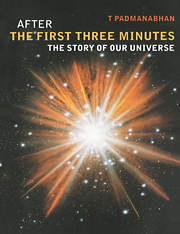6 - Forming the galaxies
Published online by Cambridge University Press: 02 November 2009
Summary
Gravitational instability
We saw in chapter 4 that our universe contains a hierarchy of structures from planetary systems to super clusters of galaxies. Between these two extremes we have stars, galaxies and groups and clusters of galaxies. Any enquiring mind will be faced with the question: how did these structures come into being?
Is it possible that structures like our galaxy have always existed? The answer is ‘no’ for several reasons. To begin with, stars are shining due to nuclear power which runs out after some time. So it is clearly impossible for any single star to have existed for infinite amount of time. One can, of course, recycle the material for a few generations but eventually even this process will come to an end when all the light elements have been exhausted. So clearly, no galaxy can last for ever. Secondly, we saw in chapter 5 that – at the largest scales – the universe is expanding, with the distance between any two galaxies continuously increasing. This led us to a picture of the early universe with matter existing in a form very different from that which we see today. It follows that the structures like galaxies which we see today could not have existed in the early universe, which was much hotter and denser. They must have formed at some finite time in the past.
How early in the evolution of the universe could these structures have formed? As we shall see, we do not have a definite answer to this question. However, we saw in the last chapter that neutral gaseous systems formed when the universe was about 1000 times smaller.
- Type
- Chapter
- Information
- After the First Three MinutesThe Story of Our Universe, pp. 126 - 170Publisher: Cambridge University PressPrint publication year: 1998

